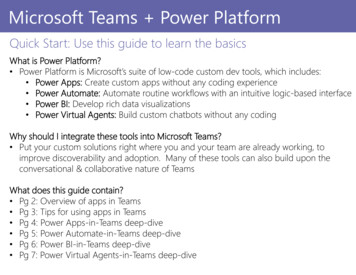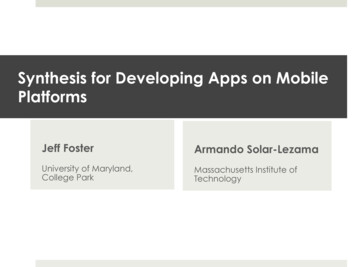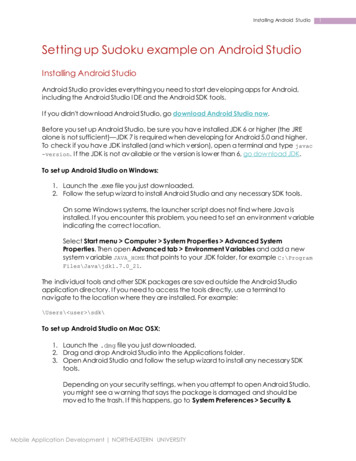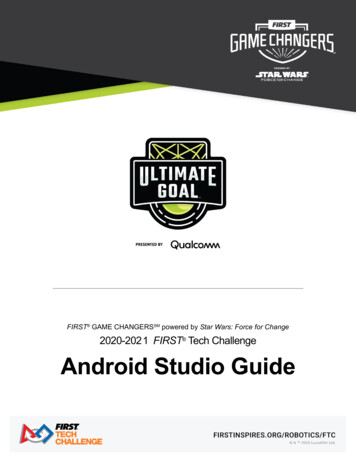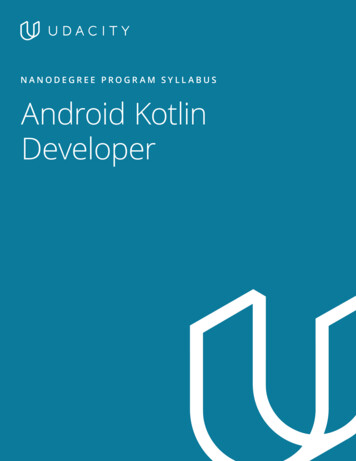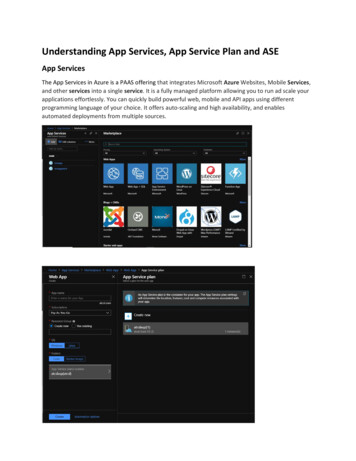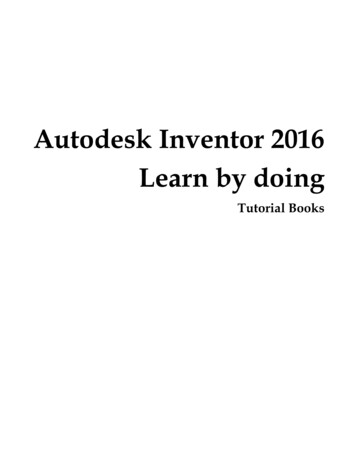
Transcription
Android Apps withApp Inventor
This page intentionally left blank
Android Apps withApp InventorThe Fast and EasyWay to BuildAndroid AppsJörg H. KlossUpper Saddle River, NJ Boston Indianapolis San FranciscoNew York Toronto Montreal London Munich Paris MadridCapetown Sydney Tokyo Singapore Mexico City
Many of the designations used by manufacturers and sellers to distinguish their products are claimed as trademarks. Where those designations appear in this book, andthe publisher was aware of a trademark claim, the designations have been printedwith initial capital letters or in all capitals.Editor-in-ChiefMark TaubThe author and publisher have taken care in the preparation of this book, but make noexpressed or implied warranty of any kind and assume no responsibility for errors oromissions. No liability is assumed for incidental or consequential damages in connection with or arising out of the use of the information or programs contained herein.Development EditorSonglin QiuThe publisher offers excellent discounts on this book when ordered in quantity for bulkpurchases or special sales, which may include electronic versions and/or custom covers and content particular to your business, training goals, marketing focus, andbranding interests. For more information, please contact:U.S. Corporate and Government Sales(800) 382-3419corpsales@pearsontechgroup.comFor sales outside the United States please contact:International Salesinternational@pearson.comVisit us on the Web: informit.com/awLibrary of Congress Cataloging-in-Publication DataKloss, Jörg H.Android Apps with App inventor : the fast and easy way to build android apps / JörgH. Kloss.p. cm.Includes bibliographical references and index.ISBN 978-0-321-81270-4 (pbk. : alk. paper)1. Application software--Development. 2. Android (Electronic resource) 3. Opensource software. 4. Smartphones. 5. Mobile computing. I. Title.QA76.76.A65K614 2012005.3—dc232011047948Acquisitions EditorTrina MacDonaldManaging EditorJohn FullerProject EditorAnna PopickCopy EditorJill HobbsIndexerJack LewisProofreaderLori NewhousePublishingCoordinatorOlivia BasegioCover DesignerChuti PrasertsithCompositorVicki RowlandTranslatorAlmut DworakCopyright 2012 Pearson Education, Inc.All rights reserved. Printed in the United States of America. This publication is protected by copyright, and permission must be obtained from the publisher prior to any prohibited reproduction, storage in a retrieval system, or transmission in any form or byany means, electronic, mechanical, photocopying, recording, or likewise. To obtain permission to use material from this work, please submit a written request to PearsonEducation, Inc., Permissions Department, One Lake Street, Upper Saddle River, NewJersey 07458, or you may fax your request to (201) 236-3290.LEGO and MINDSTORMS are registered trademarks of the LEGO Group.ISBN-13: 978-0-321-81270-4ISBN-10:0-321-81270-0Text printed in the United States on recycled paper at Edwards Brothers Malloy inAnn Arbor, Michigan.Second printing, September 2012Kloss FM.indd 49/20/12 1:07 PM
Contents at a GlancePreface by Hal Abelson xvPreface xviiAcknowledgments xxiAbout the Author xxiiiIntroduction 1I: Preparing Your First App131 Preparation and Installation152 The Development Environment3 Developing Your First App3981II: Easy Projects as a Warm-Up1314 Basic Terms and Central Concepts5 The AI References1396 Graphical User Interface7 Multimedia1331471758 Example Project: Creating a Media CenterIII: On the Way to Becoming an App Developer9 Program Development Basics10 Storage and Databases305IV: Developing Attractive Apps11 Graphics and Animation12 Sensors37513 Communication433223327329211221
viContents at a GlanceV: Useful Things for the Developer14 Special Functional Areas15 Tips and Tools527A Additional ResourcesIndex 545513541511
ContentsPreface by Hal Abelson xvPrefacexviiAcknowledgments xxiAbout the AuthorxxiiiIntroduction 1Structure and Overview 2Part I: Preparing Your First App2Part II: Easy Projects as a Warm-Up 2Part III: On the Way to Becoming an AppDeveloper 3Part IV: Developing Attractive Apps 3Part V: Useful Things for the Developer 4Companion Website5Requirements 5History6App Inventor at Google 6Open Source and App Inventor at MIT9I: Preparing Your First App 131 Preparation and Installation 15System Requirements 17Computer Platform17Android Platform 19Java Configuration 23Login Data for App Inventor 27Installation of the App Inventor Setup Software 29Android Device Settings 332 The Development Environment 39Welcome to App Inventor! 40App Inventor Designer 41Creating a Project in the Design Area 42Five Panels 44Inventory of Palette Components 45Kloss FM.indd 79/24/12 9:48 AM
viiiContentsDesigning Apps with Component Objects in theViewer 47Structuring Objects Under Components andMedia 49Setting Component Properties 49Managing and Saving App Projects 50App Inventor Blocks Editor 53Developing App Functions from Blocks 56Generic Block Groups Under the Built-In Tab 56Component-Specific Blocks Under My Blocks 57Implementing and Editing Apps in the Editor 59Integrate Android Phone 63Connecting the Smart phone to Blocks Editor 63Restart in Case of “Freezes” 67Finishing a Session 67Using the Emulator 69Start-Up Problems72If the Blocks Editor Won’t Start72If the Connection to the Smart phone Freezes74Other Problems 76The AI Forum 773 Developing Your First App81Creating the Project “LaughBag” 82Designing the User Interface 84Inserting the “Label” Component 85Assigning Component Names 88Setting Properties 88Adding the Interactive Component “Button” 89Uploading and Integrating Media Files 91Optimizing the App Design 93Non-Visible Component “Sound” 95Developing App Functionality 97Create Interactive App Logic 99Implementing Functional Block Structure 101Save Project Locally 103If There Is No Laughter 106Creating and Installing the App 107
ContentsixDirect Installation on a Smart phone 108A Matching Icon for Your App 110Online Installation via a Barcode 117Downloading an APK File 122Google Play and Other Android Markets 127II: Easy Projects as a Warm-Up 1314 Basic Terms and Central Concepts133Properties and Property Blocks 133Events and Event Handlers 135Methods and Method Blocks 1375 The AI References139Component Reference 139Blocks Reference 143Concepts Reference 1456 Graphical User Interface 147Displaying Text with the Label Component 147Triggering Actions with the Button Component 150Selecting Options with the CheckBox Component 153Entering Text with the TextBox Component 158Entering Confidential Text with the PasswordTextBoxComponent 161Displaying Notices and Alerts with the NotifierComponent 164Tidying the Screen with the Screen ArrangementComponents 167Actions at App Start with the Screen Component 1717 Multimedia175Media Access Options 175The Basic Principle: Synergy178Displaying Local and Online Images with the ImageComponent 179Taking Photos and Displaying Them with the CameraComponent 183Managing Images with the ImagePickerComponent 188Kloss FM.indd 99/24/12 9:48 AM
xContentsSound Effects and Vibration with the SoundComponent 192Playing Audio Files with the Player Component 195Playing Movies with the VideoPlayer Component 199Recording Audio with the SoundRecorderComponent 2038 Example Project: Creating a Media Center211Ergonomic Redesign of a Media Center 211Multiple Screens for the Media Center 215III: On the Way to Becoming an App Developer9 Program Development Basics221223Elements of Data Processing 224Data Types 225Data Structures 225Control Structures 227Using Colors with the Color Block Group227Predefined Colors 227Defining Your Own Colors 227Processing Numbers with the Math Block Group 229Basic Arithmetic 229Scientific Arithmetic230Generating Random Numbers 230Sorting and Converting 231Relational Operators 231Checking Program States with the Logic BlockGroup 232Boolean Values 232Boolean Operators 233Editing Text and Strings with the Text Block Group 234Comparing and Sorting 235Joining and Changing 236Checking and Searching Content 237Splitting Strings and Generating Lists 238Defining Container Structures with the Definition BlockGroup 241Variables 242
ContentsProcedures and Arguments 243Procedures with Results 245Managing Lists with the List Block Group 247Checking the Content of and Converting Lists 248Searching and Reading List Items 250Adding, Replacing, and Deleting List Items 251Controlling Program Flow with the Control BlockGroup 252Conditional Statements and Branches (if-thenelse) 253List-Specific and Numeric Loops (for) 256Generic Loops (while) 260Closing an App Properly266Tips for Program Development 267Better Overview by Using Comments 270Complaints and Error Messages During LiveDevelopment 271Testing and Debugging 274Developing More Quickly and Comfortably 277Example Projects 278Classic Calculator 278Quiz Game with Numbers 286Vocabulary Trainer: English–German 29210 Storage and Databases305Saving Data Locally with the TinyDB Component 306Saving Values of Variables as Persistent Data 307Loading Local Data from a Dictionary 311Deleting App Data from the Android System 313Saving Data on the Web with the TinyWebDBComponent 313Storing the Dictionary in the Cloud 316Shared Database for Master and Client Apps 323IV: Developing Attractive Apps 32711 Graphics and Animation329Painting as if on a Canvas with the CanvasComponent 330xi
xiiContentsColored Dots with Different Brush Sizes 332Drawing Lines by Dragging on the Screen 337A Painting Program with an Undo Function 342Animations with the Ball and ImageSpriteComponents 345Moving Graphic Objects 349Collision Detection 351A 2D Squash Game with Dynamic Animation 355Controlling Automatic Processes with the ClockComponent 358External Control of Animations361Keyframe Animations with Your Finger 366An Alarm Clock with Timer Events 36912 Sensors375Measuring Orientation with the OrientationSensorComponent 376Basics of Sensory Orientation Measurement 376A Compass with a Graphical Direction Indicator 379A Spirit Level with a Graphical Level Indicator 383Measuring g-Force with the AccelerometerSensorComponent 387Basics of Sensory Acceleration Measurement 387Use Your Phone as a Shaker MusicalInstrument 389Setting the Measurement Sensitivity via SliderControl 393A Balance Game for the Whole Body 397Determining Geoposition with the LocationSensorComponent 403Background of GPS and Location-BasedServices 404Geocoordinates and Decimal Separators 405A Geotracker for Tracking Your Route Profile 409Geocaching with Your Smart phone 42113 Communication433Task: Developing a Driver Assistance System 434Demand, Functions, and Requirements435Modular Design of the App Structure 436
ContentsSwitchboard with Multiple Screens 437Making Telephone Calls via Speed Dial List 440Picking Phone Numbers with the PhoneNumberPickerComponent 442Selecting Speed Dial Numbers with the ListPickerComponent 445Making a Call with the PhoneCall Component 448Managing SMS Messages Fully Automatically 450Generate a Reply with an Optional Geoposition 453Letting Android Read Your SMS Aloud with theTextToSpeech Component 454Dictation and Voice Recognition with theSpeechRecognizer Component 456Receiving, Evaluating, and Sending SMS Messageswith the Texting Component 458Data Exchange via an Interface462Sharing Use of Apps and Web Services via theActivityStarter Component 462Pedestrian Navigation with Integrated GoogleMaps 467Car Navigation with Integrated GoogleNavigation 473Identifying and Using Activities with ADB 476Selecting Contacts with the EmailPicker andContactPicker Components 478Sending E-Mails with Integrated Android Mailer 482Mobile Mashups with Web Services487Using Web APIs with the Web Component 489Stock Market Ticker with Data from Yahoo 492News Ticker with Data from Feedzilla 496Integrating Websites in Your App with the WebViewerComponent 502V: Useful Things for the Developer 51114 Special Functional Areas513Application-Specific Components 513Tweeting with the Twitter Component 513Reading Barcodes with the BarcodeScannerComponent 515xiii
xivContentsOnline Elections with the Voting Component 515Data Tables with the FusiontablesControlComponent 516Dedicated Component Groups 518Online Multiplayer Games with the GameClientComponent 518Exchange of Data with the BluetoothClient andBluetoothServer Components 519Controlling Robots with the Lego MindstormsGroup 521Java Interface with the AI Java Bridge 52315 Tips and Tools527Supported Media Formats 527Audio Formats 527Image Formats 528Video Formats 529News from the Developer Forum 529Control with the Java Console 530Enabling the Console 530Monitoring Loading Processes in AI 532Using Status Information 533Setting Up the Speech Module 535Installing Text-to-Speech 535Speech Synthesis Settings 536Troubleshooting Speech Output 538A Additional Resources541On the Companion Website 541Online Sources and Interesting Links 542Official Resources 542Initiatives, Tutorials, and Collections ofExamples 543Background, History, and Outlook 544Running Your Own Service with App Inventor OpenSource 544Index545
Preface by Hal AbelsonFollowing is the original preface to this book by Dr. Hal Abelson, Professor of Electrical Engineeringand Computer Science at Massachusetts Institute of Technology (Cambridge, Massachusetts), leadingmember of the Google App Inventor Team, and director of the new MIT Center for Mobile Learning supported by Google.People have been doing personal computing since the 1980s. But today’s mobile applications are making computing “personal” as never before. Today, we carry computers withus constantly, as smartphones and pads and the new devices that are regularly emerging.More significantly, today’s personal computing is increasingly “about” us: where we live,where we work, who our friends are, what we buy, what we like, whom we talk with,and what we talk about. This personal computing is linked to global data services andinformation sources in a way that fundamentally transforms our experience and our perception of our world, just as television did for people beginning in the 1950s.Television was a consumer technology. Anyone could enjoy television, but there wasno way to adapt television to your personal needs, other than by selecting which programto watch from a variety of offerings from professional producers. Perhaps mobile computing will be similar, where we’re all limited to choosing from among predefined applications supplied by professional developers.When we created App Inventor at Google, we were motivated by the vision thatmobile computing could be personal computing technology that you can actually personalize, by creating applications for yourself and your friends, without having to be anexpert programmer. Perhaps you might create applications because you want to fulfill aspecial need, or learn about computing, or try your hand at distributing and selling applications, or just have fun.App Inventor became available for general use in December 2010. It’s still a beta system under development, and the Google team is working to make it more powerful andeasier to use. But there is already a growing community of App Inventor users of all ageswho are exploring and experiencing what it’s like to make applications for themselves.Some of the things they are creating are:nnnnnnnnAn application for sending and redeeming gift cardsA guide to a major medical reference bookA controller for a Lego robotAn inventory tracker for a commercial vehicle manufacturer
xviPreface by Hal AbelsonnnnnEducational programs in reading and mathematics for their kidsMany kinds of gamesYou can make applications like these, too, and this book shows you how, startingwith the basics of how to access the App Inventor system from the Google website andconnect your mobile phone, through pointers on developing applications that use thephone’s built-in accelerometer, orientation, and location sensors. Along the way, you’llget a solid introduction to creating applications with text and data and to working withimages and animation. You’ll learn how to control the phone’s camera, how to manipulate databases on the phone and on the Web, and how to create games, send text messages and make phone calls, and manipulate maps. Each topic is accompanied by workingapplications and thorough explanations.Could this be your first step toward a future in designing mobile applications? Perhaps.Even if it is not, you’ll find that you can be creative and empowered with a technologythat’s playing an increasingly central role in your life, and the lives of us all.—Hal AbelsonMIT Center for Mobile LearningGoogle App Inventor TeamMarch 2011
PrefaceTreasons.here could not be a better time than today to start developing Android apps, for manyMost importantly, developing your own apps has never before been easier than itis now with App Inventor. This development tool, which is offered by Google and Massachusetts Institute of Technology (MIT) and has been available since December 2010,is available free of charge for all to use. With App Inventor, you can develop your ownapps, even if you have never programmed before, using a computer or even a smartphone. With App Inventor, you can build both small and really big apps with playful easeby assembling visual building blocks, without having to write a single line of Java code.Yet App Inventor is by no means just a toy: It is an alternative and innovative tool withwhich you can develop even complex and demanding apps quickly and easily, both foryourself and for other users. Take a look at the table of contents of this book, and youwill be amazed to find that the early chapters of a book aimed at beginners containinstructions for developing apps in the areas of multimedia (photo, audio, video), graphics and animation, various forms of communication (speech, SMS, e-mail, web services),and even sensors (orientation, acceleration, GPS geoposition). In Figure P.1, you can see aselection of the apps you will develop in this book.Figure P.1 Android apps developed in this book
xviiiPrefaceThe quick and easy start and the equally quick and intuitive development of attractiveand demanding apps are the declared aims of the visual development tool App Inventor.App Inventor is aimed at a far larger target group than ordinary development tools. WithApp Inventor, all users of Android smartphones now have the chance to peek behind thescenes at the colorful world of apps, then have a go themselves and express their creativity by designing their own apps. Where those apps go is entirely up to the developer’sindividual preferences, topical emphasis, and personal motivation. You as a user can decidewhether your own app is “just” a personal digital picture frame, a quiz game, a vocabulary trainer with a potentially shareable online database, or a geotracker for automaticallycreating a route profile while the user is hiking. The future will show to what extent the“users” of such personal apps eventually turn into “developers”—that is, whether theyevolve from “passive consumers” to “active producers,” thereby triggering a mini-revolution in dealing with the most modern forms of communication technology. Nevertheless,even experienced developers can profit from using App Inventor, as it enables them toproduce professional prototypes and apps much more quickly and, therefore, more costeffectively. Come and take part in these “developments” and get to know App Inventorby reading this book. You will learn to use it for your own purposes and soon appreciateits value as an immensely powerful developer tool.Owing to its rich set of properties and features, App Inventor is in the right place atexactly the right time. Now that many billions of dollars have been invested in licensesand establishing the mobile telecommunications network infrastructure, the mobile datanetworks of the third generation (3G: UMTS, HSDPA) and fourth generation (4G: LTE)are available almost anywhere and at any time, with a data flat-rate tariff often being usedas the basis for fast data services, mobile Internet access, and web services. In turn, the newdevelopments by manufacturers of mobile devices keep coming in a rush. Moreover, aftera deluge of new smartphones with incredible technical specifications for domestic use,the next generation of tablet PCs is being embraced by a growing number of customerswho are willing to pay for them. The providers of online services and web services are alsoeager to make use of the new mobile possibilities and to offer the increasingly communicative Web 2.0 users mobile extensions such as location-based services and proprietaryapps on the growing app market. The competition between the mobile operating systemsappears almost calm and seems to be more or less settled, the “top dogs” have long sincebeen pushed out, and, after an initial neck-and-neck race, the triumph of Android as theoperating system of choice for smartphones now seems certain. With its open approach,the resulting flexibility, its free availability, and its integrative access to the entire rangeof features of the manifold Google Services, Android has qualities that the other mobileoperating systems lack.Despite the impressive technological advancements, users nowadays are no longeronly interested in pure technical features and details. Although the Internet first startedto develop thanks to just a few technologically minded enthusiasts, it has long since beentransformed from a mass medium for consuming news, information, and entertainment(Web 1.0) to an active, commonplace form of communication between people (Web 2.0).Today the focus is not so much on the technology, but rather on the communication,
Preface creativity, and individuality that people can apply and express with it. This trend partlyexplains the increasing willingness of users to invest time and effort into creating theirown profiles in social networks, to establish their own blogs, and participate in chats oronline games, but also to invest money in the form of fixed and mobile telecommunications charges and the newest and most fashionable hardware. Regardless of whichforms of expression users’ individuality and creativity may take in the age of digital andnetworked communication, App Inventor offers entirely new possibilities for exercisingthem. Previously, users were able to move only within the predetermined limits set by thehardware manufacturer, the platform operator, and the app developer; now they can atleast overcome the latter by using App Inventor, thereby gaining a piece of freedom andindependence—a factor that should not be underestimated. Even if you do not have suchambitious aims, you can still have fun when developing your own apps with App Inventor.After reading this book and working your way through the many example apps, you willsee the colorful app world with different eyes. And almost without noticing it, you willhave become a developer of Android Apps. So, what are you waiting for?xix
This page intentionally left blank
AcknowledgmentsIwould like to thank everyone who has supported me during the creation of this book,directly or indirectly. This includes not least the members of the Google App InventorTeam, whose incredibly dedicated work has made such a fascinating developer tool asApp Inventor and, therefore, many impressive apps—and this book—possible in the firstplace. I am especially grateful to Hal Abelson, Professor at the legendary MIT, centralimpulse giver within the Google App Inventor Team, and director of the MIT Center forMobile Learning, for his inspiring and courageous work on this and the previous projectsand for providing the preface to this book.For the English-language revised and updated edition of this book, I would like tothank my colleagues in the German publishing house, Brigitte Bauer-Schiewek andAngelika Ritthaler, and in the United States, Jill Hobbs, Trina MacDonald, Anna Popick,and Songlin Qiu. I am particularly grateful to Almut Dworak for the excellent translationwork and, beyond that, for the helpful comments and feedback on the book.My thanks also to those who had so much patience with me while I was writing thisbook: my parents, my sister, Maximilian, Benedikt, and, above all, Alexandra.—Jörg H. KlossJanuary 2012
This page intentionally left blank
About the AuthorJörg H. Kloss has worked for many years with innovative information and communication technology, including its development, programming, and use in both private andprofessional areas. His private-sector beginnings with the Amstrad CPC and the programming language Basic were followed by deeper explorations at university in the area of artificial intelligence and computer linguistics, working in Pascal, C, C , and Java, but alsoin specialized languages such as Lisp and Prolog. Mr. Kloss was one of the early pioneersof virtual reality (VR), augmented reality (AR), and interactive 3D worlds on the Internet.He began development work on commercial VRML-based online information systems inthe mid-1990s, has worked at the renowned German VR lab of the Fraunhofer Institutefor Industrial Engineering (FhG-IAO) and the American VR-Entertainer StrayLight, andwas president of the European division of the VR Alliance of Students and Professionals(VRASP). In addition to numerous presentations, contributions, and other publications,Mr. Kloss has written two books that were published (in German) by Addison-Wesley:VRML97: Der neue Standard für interaktive 3D-Welten im World Wide Web (VRML97: TheNew Standard for Interactive 3D Worlds in the World Wide Web; 1998) and X3D: Programmierunginteraktiver 3D-Anwendungen für das Internet (X3D: Programming Interactive 3D Applications forthe Internet; 2010).After developing early industrial projects based on 3D multiuser worlds for an international media house as well as for remote maintenance via the powerline of a largeenergy supplier, Mr. Kloss focused on telecommunications for many years, taking part ininnovative projects involving multimedia data and voice technologies in the areas of fixedand mobile network communications (IP, TDM, VoIP, 3G, 4G). As these technologies haveconverged, Mr. Kloss has dealt increasingly with the potential of mobile data networksand services in the context of mobile augmented reality, ubiquitous computing, and contextual services. He has actively taken part in the development of Android apps with AppInventor since the early closed-beta phase.
This page intentionally left blank
IntroductionTone,hisofferingbook is a compendium, a practical course book, and a comprehensive tutorial ina collection of example projects for smaller and larger applications (apps) forAndroid devices. As a compendium, it addresses, introduces, and demonstrates more orless comprehensively every single area and almost every component of the App Inventordevelopment tool as it was available at the time when the book was written. Consequently,this book can be used as a reference work even by experienced developers who are looking for specific instructions and information about a certain functional area. Presentingexamples from a wide variety of topics, it also serves as a practical course book on thegeneral development of apps for mobile devices with their specific multimedia, communication, and sensory properties as well as system elements that often remain unchartedterritory even for the experienced PC programmer. Along with the basic aspects of application development, program structures, and functional elements, the example projectsdemonstrate approaches and solution strategies for the typical problems that can arise inthe context of mobile applications.As a comprehensive tutorial, this text is aimed mainly at beginners and their needs.Both the structure of this book and the development tool App Inventor are written withbeginners in mind, with a clear focus on practical application. If you are a newcomer toprogramming in general or to app development for mobile devices in particular, specifically for Android smartphones, or if you are simply adopting the development tool AppInventor, the introductory chapters of Parts I and II of this book will provide you withthe level of knowledge you need and guide you step by step through the developmentof Android apps with App Inventor. The many accompanying example projects and appsillustrate and extend what you have learned, invite you to experiment and try things outfor yourself, and provide a starting point inspiring you to creatively develop your ownapps. You will learn progressively in line with the sequential structure of the book’s chapters, the topics and functional areas addressed, and the example projects we develop, all ofwhich usually build on the knowledge gained in the preceding chapters. Along with covering the many functional areas and elements, the book also discusses basic methods ofprogram development and explains how to use App Inventor’s online resources, therebypreparing you to undertake your own development work in the future. In the process,the perspective gradually changes from the initial perspective of the beginner looking atindividual components and their functions to the view of the developer focusing on theactual tasks the app performs and strategies to implement them with App Inventor.
2 IntroductionStructure and OverviewIf you take a quick look at the table of contents, you will see that this book is dividedinto five parts. These parts are not so much devoted to different topics, but rather reflectthe intended evolution of the reader from the beginner working with App Inventor forthe first time to the developer of advanced and complex apps—which we certainly hopewill occur while you are reading this book and working through the chapters. This structure emphasizes the tutorial nature of this text; thus we recommend reading and workingthrough the chapters in
Android Apps with App inventor : the fast and easy way to build android apps / Jörg H. Kloss. p. cm. Includes bibliographical references and index. ISBN 978-0-321-81270-4 (pbk. : alk. paper) 1. Application software--Development. 2. Android (Electronic resource) 3. Open source software. 4
